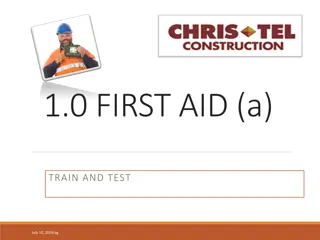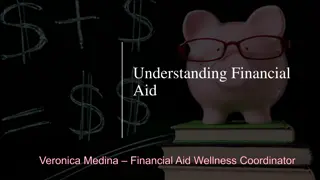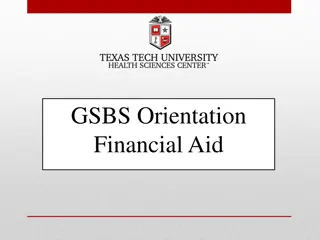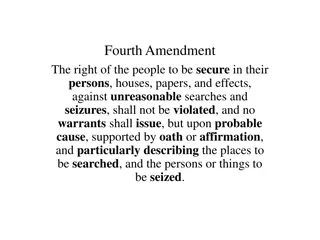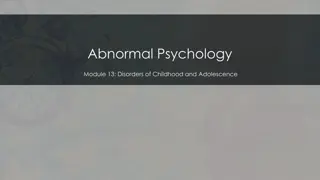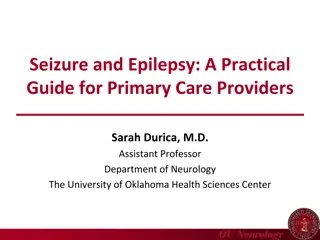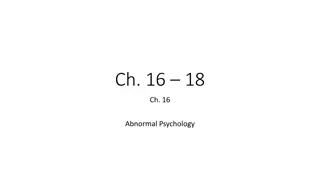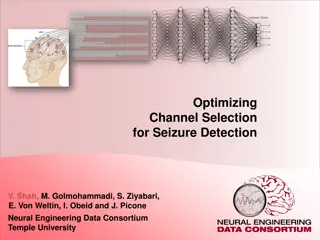Understanding Seizure Disorders and First Aid
Seizure disorders can have varying symptoms and may occur at any time in life. Immediate medical treatment is crucial for the first seizure. Factors like stress, illness, temperature changes, and photosensitivity can impact seizure thresholds. Different types of seizures, including focal aware tonic seizures and focal impaired awareness seizures, have distinct signs. Proper care during a convulsive seizure involves staying calm, not restraining the person, protecting the body and head, and placing the person on their side.
Download Presentation

Please find below an Image/Link to download the presentation.
The content on the website is provided AS IS for your information and personal use only. It may not be sold, licensed, or shared on other websites without obtaining consent from the author. Download presentation by click this link. If you encounter any issues during the download, it is possible that the publisher has removed the file from their server.
E N D
Presentation Transcript
Seizures Many individuals have known seizure disorders. The symptoms may vary. A seizure disorder can occur at any time in life. It is very important to receive immediate medical treatment for the first seizure that a person may have. It may be of unknown cause or may result from a brain injury such as from a fall with a blow to the head. A new seizure disorder must be carefully looked at to rule out brain tumor. Topic/ function It is important to know what is normal for a person. A change from normal needs to be reported to a healthcare provider.
https://www.epilepsy.com/learn/seizure -first-aid-and-safety
Even with therapeutic blood levels of anticonvulsant medications, certain events can alter a person s seizure threshold: Stress, emotional upset Even with therapeutic blood levels of anticonvulsant medications, certain events can alter a person s seizure threshold: Physical Illness or infections Temperature change Photosensitivity
Recognizing Focal aware tonic seizures (generalized grand mal) seizures are the most easy to recognize. Some signs are: Loss of consciousness Loss of bladder or bowel control Eyes may roll back into head No control of movement, speech or actions Person may initially stop breathing or they may look pale, lips may turn blue Convulsions Following the seizure the person may be very tired and need to rest. An aura is a partial seizure that may occur prior to a generalized seizure. An aura is experienced as a particular sensation that may precede a generalized seizure. People who experience am aura may sit down or not get up from a chair recognizing that they are about to have a seizure.
Focal impaired awareness(complex partial) & Focal aware(simple partial)seizures may be difficult to recognize especially in non-verbal individuals. Some signs are: Decrease in the level of consciousness but no loss of consciousness Person unable to respond Facial movements, eye or mouth movements Drooling or purposeless behavior (lip smacking ) Shaking or jerking of a body part (i.e. arm/ hand or leg/ foot) Sudden emotional response, may cry out or laugh. Wandering, may run in fear Nausea
Care During a Convulsive Seizure: Remain calm Do not restrain the person Protect body and head from sharp objects, remove eyeglasses Loosen clothing around the neck Turn person on their side to protect airway Never place your hands or anything in the mouth of person having a seizure Track the time of the seizure and be able to describe what it looked like For a Non-convulsive Seizure: Do not restrain Stay calm and track time Redirect person from hazards Do not agitate, speak calmly Always stay with individual having seizure Individualized Seizure protocol- a protocol to follow written by doctor or neurologist for a specific person. It s a guideline on when to call EMS and when to call the doctor.
INDIVIDUALIZED SEIZURE PROTOCOL NAME_____________________________________DOB____________ CALL EMS (911) If seizure last greater than __________minutes And/or: If the individual has one seizure after another If the individual has been injured If individual has a seizure who has an INACTIVE pattern (greater than one year) Other : CALL NEUROLOGIST: If the individual experiences ___________seizures in 24 hour period If the individual experiences___________seizures in a week If the seizure last longer than _________minutes If the individual has a seizure who has an INACTIVE pattern (greater than one year) If post seizure behavior ( confusion, agitation, decrease in activity etc.) continues longer than 30 minutes Additional Information_____________________________________________ ______________________________________________________________ HCP Signature____________________________ Date: ________________ Neurologist name: _________________________ Tel # : ________________ ALL SEIZURES MUST BE REPORTED TO THE AOC & A SEIZURE REPORT MUST BE COMPLETED AND FAXED TO C.O Growthways, Inc. Community Supports for People with Developmental Disabilities 41 North Pearl Street, Brockton, MA 02301 (508) 941-6505 fax 583-7651 W W G G YES NO YES NO YES NO YES NO YES NO YES NO
STAY CALM PROTECT head (remove eyeglasses) LOOSEN clothing TURN person ON SIDE to protect airway TRACK TIME DO NOT PANIC DO NOT RESTRAIN NEVER PLACE ANYTHING IN MOUTH DO NOT LEAVE THE PERSON DO DO DO NOT
Treatments for management include: Medication Vagal Nerve Stimulator Surgical intervention
Medications are used to minimize or block the spread of electrical stimuli. Approximately 70-80% of people use one or more anticonvulsants to control seizures Most anticonvulsants require time to reach therapeutic levels Some seizure medications can build up in the body and become toxic and sick. Being toxic can cause more seizures. . Blood tests are done to see if medication is therapeutic People can be very sensitive to medication changes. Missed doses or med changes can increase risk of seizure activity.
Status epilepticus (individual has one seizure after another ) Status epilepticus is a medical emergency) The individual does not resume breathing after the seizure. Give CPR. Significant bodily injury A first time seizure or a change in an individual s seizure pattern Any seizure lasting more than 5 minutes unless otherwise indicated by the health care provider.
Reassure individual. They may be very tired and require rest. Stay with the individual until they are fully awake and oriented. Do not offer food or drink until the individual is fully conscious. Follow the individualized seizure protocol for additional care & notification. If individual is having an increased number of seizures call the HCP. Document seizure and complete Seizure Observation Report Seizure Observation Report- a form that you fill out when an individual has a seizure. It gives a report of what you directly observed happening before, during and after the seizure
What to document: Time it started How long it lasted What the seizure looked like What happened after seizure Seizure Observation Report



